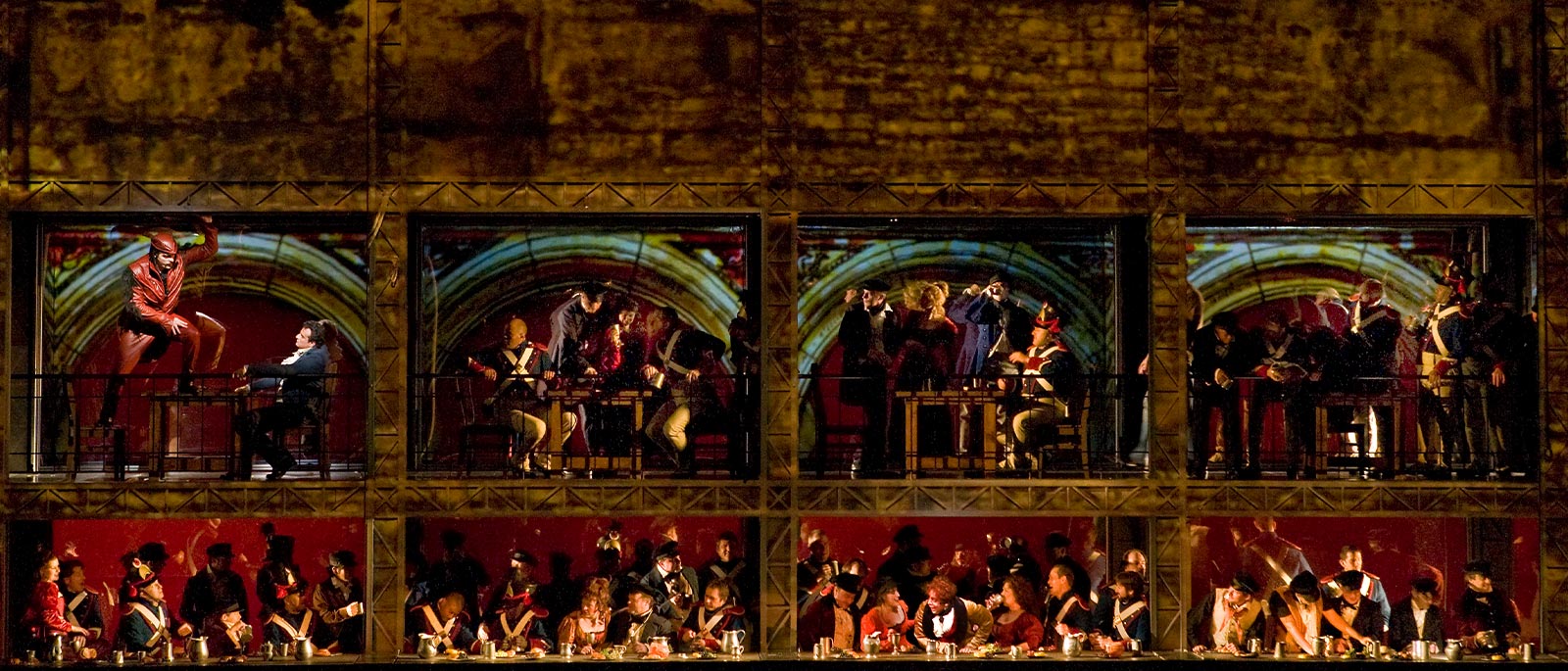
Modern Marvel
Robert Lepage’s 2008 production of La Damnation de Faust is an inventive marriage of traditional stagecraft and visionary technology. The creative wizard behind visually stunning shows for artists and companies ranging from Peter Gabriel to Cirque du Soleil to Seiji Ozawa, Lepage is at heart a master storyteller with the gift of being able to develop and harness technology to serve his intimate, human stories. On the eve of the production’s premiere, the visionary director discussed his approach to staging Berlioz’s grand “dramatic legend.”
How would you describe your visual approach to La Damnation de Faust?
I was interested to find a meeting point between the theatricality of opera and the cinematic world, to create a kind of portal where those two ways of telling stories would come together. So we created a kind of double wall that looks a bit like scaffolding at times. We have performers within that wall and we have projections coming from the back and from the front, so the three-dimensional, real-life performers are caught in a sandwich of cinematic realities. At first the singers were a bit afraid of it, but then they found that it’s a very friendly environment for their voices—we’re blocking the proscenium arch with this huge mirrored wall, so the voice actually bounces back into the room.
Why is this opera suited to this unusual treatment?
The original Faust story is like a real movie. You start in a very small study with this bitter old man. Mephisto appears and kind of drags him out into the real world and tries to give him all these different sensual experiences. The opera world, the theater world, is conceived as kind of a static place, and the challenge for this production is to try to bring the audience into the role of Faust—giving them different experiences, different sensations, entering different sensual worlds. So it’s a very, very cinematic vocabulary that is being used.
You staged an earlier incarnation of Damnation in 1999. How have you reconceived the production for the Met?
All the visuals are redesigned. And we’re also adding this new tool: interactive video. It is a very tricky thing, but when it works, it really works wonders. It is not recorded images. The images are somewhere in a memory bank and are triggered by the performances of the singers—whether it’s their body movements, their heat, the pitch, the tone, or the variations of their voices. All the imagery is triggered by anything they do, so you never lose touch with the performer. It’s not some kind of new razzmatazz gadget that blurs the production or gives the performer a second role. It actually enhances his performance.
It must be exciting to be able to take advantage of these technological advances.
It’s a director’s dream to do all these things, but the technology is not necessarily up to date, so you compromise and find different ways to realize your ideas. The more we restage this production, the more the technology really helps it come to fruition. The technology is catching up with the production. Ten years ago, we were trying to project video images from the front, and you had to add many, many projectors to get the luminosity that you needed. Now one very strong projector can do that. You have an amazing definition of images that you didn’t have before.
Is there any concern that the technology could upstage the story or the performers?
I think that you have to remember what opera is about. Everything is centered on this larger-than-life voice. You’re working with sopranos and tenors and baritones and basses who are larger than life, who convey larger-than-life emotions and feelings and ideas. So the idea is to bring these exciting new tools and put them at the service of that central thing, which is the humanity of the voice. If you use the technology just as a kind of gadget or to try to show that you’re more clever than the next guy or that you can afford these things, then it’s off, and it’s going to be dismissed very early on—not only by critics, but also by the audience.
You’ve described opera as “a great meeting place.” What do you mean by that?
Frank Lloyd Wright once said that “architecture is the great mother art.” But I think that opera is the great mother art, because opera actually includes architecture. Opera invites theater, literature, music, and dance, and, of course, it has been trying in the past few decades to integrate film. I think now the tools are there to invite the logic of film into the live performance and make it feel authentic.
Do you think this is the direction opera is headed in general? Incorporating film and new technologies into productions?
Opera houses, of course, have to change and move forward. And that’s what’s so exciting about what’s going on at the Met right now. You feel that it’s welcoming this idea that opera is an up-to-date form of art. It’s not an old, dying form of art—on the contrary. But to do that you have to bring in people who don’t necessarily come from the opera world. You have to invite disciplines that are just waiting to express themselves. There are other elements just waiting to be thrown into the maelstrom.